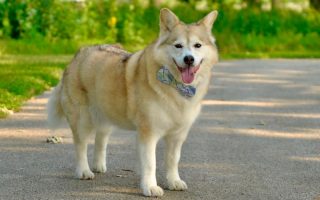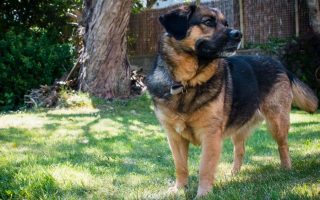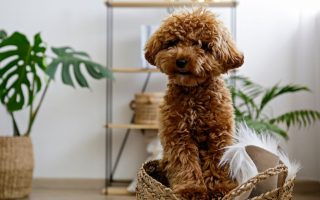The Rhodesian Ridgeback Lab mix is a designer breed that originated and rose to popularity with the trend of hybrid dogs.
Rhodesian Labrador is a cross between the Rhodesian Ridgeback and US’s most popular dog, the Labrador Retriever.
The crossbreed trend and popularity of both parent breeds have made this mix of high demand in the United States.
It is also intelligent as its parents, a plus on its side. Popularity does mean you should be more prudent to avoid a pet that’s poorly bred.
Also, its popularity doesn’t automatically make it a suitable breed for you. Being a good pet parent starts from knowing all about your preferred breed.
Personality and energy are factors that may be a deterrent for you.
Like many other mixed breeds, it also has an unusual appearance which depends a lot on the genetic combination of the parents.
Read on to learn more.
Rhodesian Labrador Mixed Breed Information
| Height | 22 to 27 inches |
| Weight | 70 to 80 pounds |
| Lifespan | 10 to 12 years |
| Coat | Short, medium, dense |
| Colors | Black, fawn, red, sable, isabella, yellow, chocolate |
| Temperament | Calm, confident, stubborn |
| Ideal For | Active families, experienced owners |
| Recognized by | Dog Registry of America (DRA) |
| Puppy Price | $750 – $1000 |
Rhodesian Ridgeback Lab Mix Puppy Characteristics
| Health | High |
| Grooming | Low |
| Friendliness | Medium |
| Energy | High |
| Trainability | Medium |
The Parent Breed
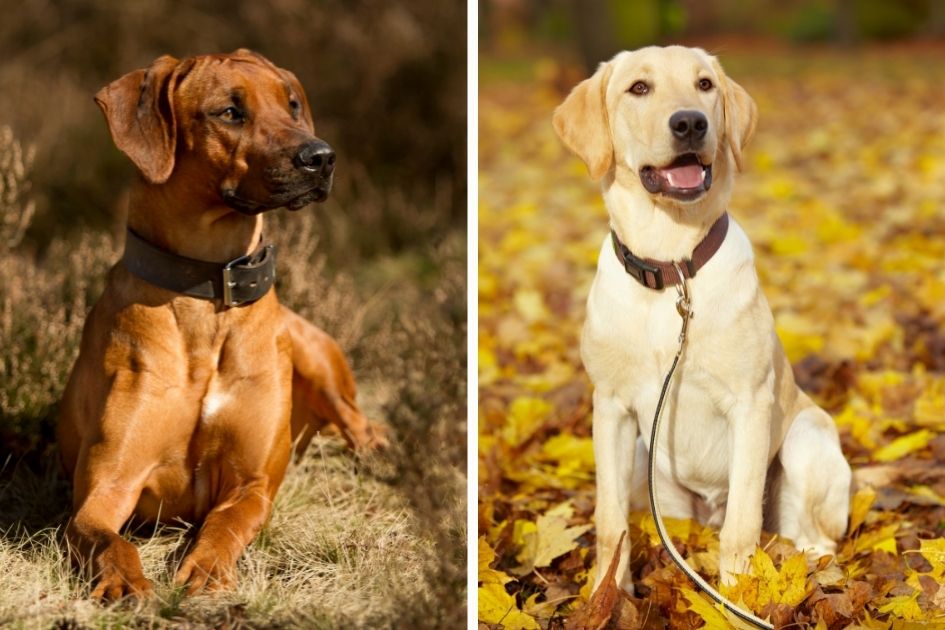
Rhodesian Ridgeback
Recognized by the American Kennel Club in 1955, the Rhodesian Ridgeback originated from South Africa and was developed to be a hunting dog.
It also played the role of a home guardian, which continues to play in modern homes. The Rhodesian Ridgeback is an excellent guard dog.
Its name was gotten from the most distinctive feature on its skin, a ridge that stretches through the spine.
The fact that it hunted lions added to its appeal, and one would expect a brave canine. This breed doesn’t disappoint.
Added to the courage is its wariness of strangers, a quality that’s good for a guardian dog.
With good training, the Rhodesian Ridgeback has no aggressive tendencies. It is stubborn, though, and needs an experienced owner.
The Rhodesian Ridgeback is a medium to a large-sized dog breed, the males being bigger (height 25 to 27 inches, weight 79 to 90 pounds) than the females (height 24 to 26 inches, weight 64 to 75 pounds).
It has a muscular frame, a short coat and often has a red color with white marks on its chest and paws. It also has either a black or brown nose.
Labrador Retriever
Recognized by the AKC in 1917, the Labrador Retriever is the most popular dog breed in the United States today and has held that position for a long time.
It originated from Newfoundlands Island and was developed to retrieve fish for fishermen. It also served as companions for the fishermen’s families.
Although they were once endangered in the 1880s and faced extinction, their fame increased after the Second World War.
Its warm personality contributes to its overall charm. The Lab is a sweet, eager to please, and intelligent dog breed.
Unlike some other retrievers and worker dogs, it is suitable for first-time dog owners because it is easy to train. It also loves activity, though some can be more laid-back.
Male Labradors stand at 22 to 24 inches and weigh 65 to 80 pounds, while the females stand at 21 to 23 inches, with a weight of 55 to 70 pounds.
They have a short and dense coat that is waterproof and oily, enabling it to swim without getting sick. The coat comes in three colors: Black, yellow, chocolate.
Important Facts About the Rhodesian Ridgeback Lab Mix You Should Know
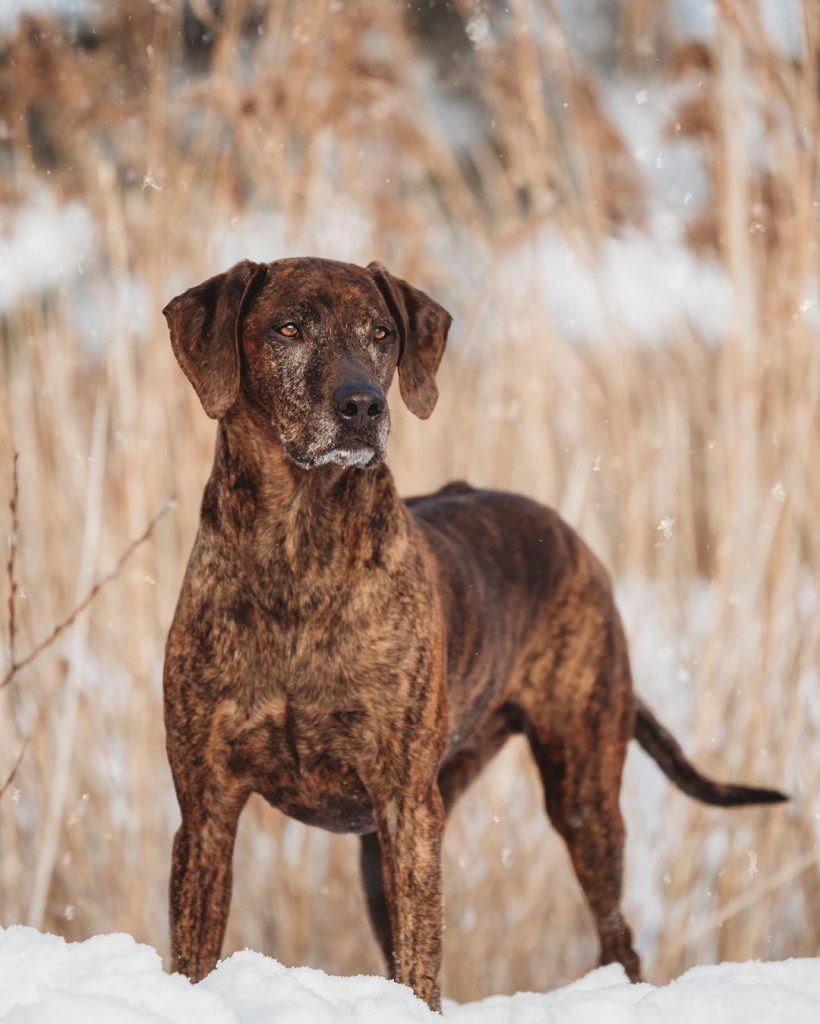
1. Rhodesian Labradors are protective
Due to the hunting instincts of both parents and the guardian role played by the Rhodesian Ridgeback, the mix has a protective streak.
It guards its territory against intruders, though it is not overly suspicious of strangers, making it easier to socialize them without taking away the guardian side.
2. It is a low maintenance dog
An upside to owning the Rhodesian Labrador hybrid is the low-maintenance coat it has. This is unlike many other dog breeds of the same size.
Even during shedding seasons, it is easy to clean up after a member of this mixed breed.
Grooming needs are low, making it a job you can undertake without professional services.
3. The Mix appearance and temperament varies
The Rhodesian Ridgeback and Labrador Retriever are close in weight but are dissimilar in looks and behavior.
While there are some traits you’re likely to find in the offspring, no two Rhodesian Labrador mix dogs look and act the same.
4. Its parent, the Rhodesian Ridgeback, was a lion hunter
The South African native breed is often regarded with awe by Americans, not just because it was a hunter, but because of its prey.
This breed was developed to go against the so-called King of Animals and bring the latter down. One should think twice before getting in the way of this Zulu canine.
5. It is a popular mix because of the Labrador
Since its rise to the top in 1991, the Labrador Retriever has retained that position for 30 years.
Because it is a friendly dog that plays many roles and is an excellent first-time dog, many pet parents start their journey with this breed.
Rhodesian Labrador Appearance

General Appearance
Like earlier noted, the Rhodesian Ridgeback Lab mix does not have a standard appearance that’s the same with every member canine.
Even puppies of the same litter may look different.
The ideal wish of many pet parents is to have a mixed breed that will combine the physical traits of the Labrador and the Rhodesian Ridgeback.
However, this may not always be the case. Some look like the Lab; others are biased towards the Rhodesian parent.
The best way to determine what a Rhodesian Lab mix will look like is through its parents.
It may get the muscles of the Rhodesian Ridgeback, the webbed toes of the Labrador Retriever, and/or the strong tail of the latter.
Some of the mixed canines may have only one webbed foot.
Size
Going through the path of its parents, the Rhodesian Lab is either medium or large.
The size may vary, but it won’t be as overt as some other designer breeds.
Generally, they weigh from 70 to 80 pounds and get a height of 22 to 27 inches. Males are often bigger than females.
Colors and Coat Type
The mix coat is usually short and dense like that of its parents. The coat could be water-resistant like that of the Labrador Retriever, but not to the same extent.
The common coat colors you’ll find on this mix are red, chocolate, black or yellow. The coat may also be fawn.
Temperament, Behavior & Intelligence of the Rhodesian Labrador Mix
The variations in behavior make it a bit complex to know what to expect with this designer breed.
One can make calculated guesses with the parents, though. Going by the parents’ traits, some qualities may appear in the offspring.
The mix may not be as reserved as the Rhodesian but may not be as outgoing as the Lab either. When it combines both temperaments, it’ll be an ambivert.
Both parents love to bond with people, so the mix will likely do so.
It may either attach to one family member like the Rhode or share equal affection to everyone like the Lab.
Indoors, this breed can maintain composure and calmness. It is not an excessive barker.
Thus, you can have it in an apartment. However, you should make provision for its size and need for exercise.
Its intelligence and confidence make it learn and retain commands with ease.
However, it tends to inherit the stubbornness of the Rhode, rather than the easy-going nature of the Lab. It is safer in the hands of a knowledgeable pet parent.
Its guardian instincts come into play when it encounters danger. Ever loyal, this breed does its best to protect its family.
Sometimes it can act aggressively to chase away an intruder. Socialization can curb this behavior, but do not expect to completely eradicate it.
Are Rhodesian Ridgeback Lab Mix Good Family Dogs?
The Rhodesian Ridgeback Lab Mix is loyal, devoted, friendly, and good with kids.
It takes the protectiveness of the Rhodesian Ridgeback alongside the warm nature of the Labrador Retriever. Together, it makes for a good family dog.
Nevertheless, not every family should own one. Unlike its parent, the Lab, it may be a poor choice for new pet parents.
It is also better for a family who lives an active lifestyle.
Are They Good With Other Dogs & Pets?
The mix can flow with other dogs but will need socialization to not get protective against canines.
When properly socialized, this breed shouldn’t have a problem in a multi-dog household.
There may be some issues with other pets as this mix has hunting instincts. Introduce it to other pets as a pup and be observant.
How Much Does a Rhodesian Ridgeback Lab Mix Puppy Cost?
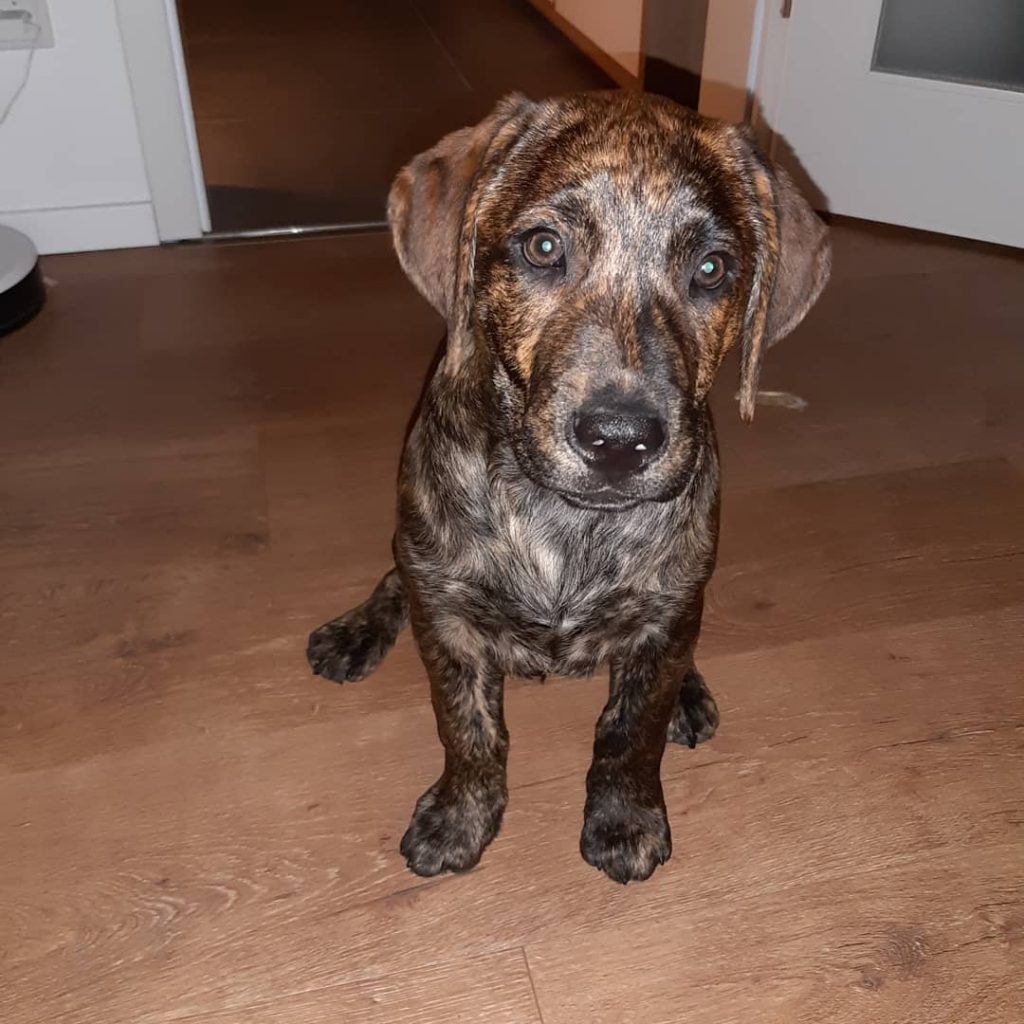
The Rhodesian Lab mix enjoys the popularity of both parents. Thus, you will need a high budget to get one.
Generally, it is slightly close in price to the Labrador Retriever but way cheaper than the Rhodesian Ridgeback.
Rhode’s price range is between $1,700 to $2,500. With the Lab, expect to spend about $800 to $1,200.
The price of the Rhodesian Labrador mix puppy is between $750 to $1,000. It could be more economical to buy the mixed breed.
When getting a designer breed, you must be selective. Mixed breeds with poorly bred parents will give you a hard time.
This phenomenon is more common with popular parents like this mix has.
To prevent future veterinarian costs, be diligent enough to find a reputable breeder.
This breeder should be able to answer any question you have and provide health records and other pieces of information on the breed. If they can’t, find another breeder.
Care to adopt? Many animal activists canvass for adoption over shopping.
It is a cheaper option, and you would be doing a service by giving a lost pup a good home.
Also, get relevant information from shelters, including any possible history of abuse, trauma, behavioral problems, or possible illnesses.
Caring for a Rhodesian Ridgeback and Lab Mix
Food & Nutrition
The Rhodesian Labrador meal requirements are similar to other dog breeds its size.
As an energetic medium to large-sized breed, its diet should be channeled to its size and energy.
Activity level matters, too, as a worker will need more than an apartment pet.
Its core nutrient is protein, similar to other dog breeds. Not only does protein supply energy, but it also helps prevent some medical conditions.
Omega-3 fatty acids are essential too, and water to keep it hydrated.
Its diet should contain glucosamine because this breed is vulnerable to hip and elbow dysplasia.
It is also prone to bloating, so the kibble of any product you get should be large. Do not allow your dog to rush its food too.
We recommend at least 2.5 cups of meal a day for this hybrid. It may be more or less, depending on size and activity level.
Schedule its meal to get it used to the routine. Do not overfeed it, and also keep food far from its reach to avoid free feeding.
A breed its size will have more health problems with obesity than smaller pooches.
Another factor to consider is age. Pups shouldn’t be fed the same as adults. They also have their specific puppy food that you should stick to till it grows.
Exercise
As an energetic designer breed, this mix should be exercised regularly, especially when it is a companion dog with no daily activity to use up its energy.
Lack of exercise is risky to their health. Its tendency to gain excess weight is unhealthy and can best be prevented with exercise.
However, do not overexercise it as that can cause injuries and joint deterioration.
A few hours walk per day is often enough to satisfy this breed’s exercise needs.
Some playtime is also appropriate, especially if you want your pet to be playful.
While not a universal rule, this breed will need about 2 hours of activity in a day and 12 in a week. The hours may be divided into shorter minutes.
While on a walk, keep your pet on a leash. Rhodesian Labs have a high prey drive that can manifest at any moment.
It would only take the sight of flying birds for your pooch to try chasing after them. A leash would help you restrain it.
Like food, exercise is influenced by age, size, and activity. A puppy should be given light exercises and mustn’t run due to its delicate bones.
A worker mix may not need as many extra activities as the household pet with nothing to do.
Exercise should also be mental, especially for an intelligent dog breed like the Rhodesian Lab. Through puzzles and other challenging games, challenge its mind.
To reduce the stubborn trait, you may face with this mixed breed, start training it as a puppy.
It is risky to put off training till your pet becomes an adult. Training should cover every necessary method that would shape up your dog.
New pet parents are not advised to get the Rhodesian Labrador mix.
They’ll fare better with the Labrador Retriever parent, whose eagerness to learn and obey makes it easier to train.
The independent spirit of the Ridgeback is usually in the mix, making training a more challenging task.
Obedience training is the first process you should implement.
Teach your pup simple commands that it can learn, such as Sit, Down, and Roll. Reward it with a treat when it obeys.
You should also socialize this breed due to its tendency for protectiveness and wariness against strangers and other dogs.
Left unbalanced, it can make this breed turn aggressive.
House-training is important as well because this breed stays indoors sometimes.
You do not want your furniture getting chewed on, so train your pooch to behave in a living room.
Harsh methods can make this breed get withdrawn and sulk, so you should never use them.
The ideal owner knows how to be patient and gentle yet firm in training.
Grooming Needs
The Rhodesian Labrador mix has a low grooming need and can be kept clean with minimum effort.
It sheds moderately and should be brushed once or twice a week. If the hybrid gets the Lab’s coat, it’ll need more brushing than if it inherits that of the Ridgeback.
Bathing should not be as regular as brushing for this breed. Unlike humans, too much bathing can be detrimental to a dog’s skin. Only bathe them if they get messy.
The ears of Rhodesian Labrador need extra care as they can get infected.
With a vet-approved ear cleaner and cotton wool, clean off the surplus wax and check out for ear infections.
Trimming of nails should also be done with care. If you’re inexperienced in it, hire a groomer.
Also, take care of your dog’s teeth with a toothbrush, toothpaste, or dental spray.
Some important tools you need for grooming are a bristle brush, vacuum cleaner, a good shampoo, ear cleanser, and dental kit.
Health & Conditions
Compared to other breeds, the Rhodesian Labrador has a shorter life span.
Nonetheless, it is a healthy breed and can live without frequent visits to the veterinarian.
This is because mixed breeds are generally healthier than pure breeds.
That said, it has some medical conditions you should look out for, which include:
- Hip and elbow dysplasia: These are both joint-related conditions that affect a dog’s movement. Abnormalities in the elbow joint and hip joint leads to this dysplasia. They can render a dog lame.
- Bloat: This is a serious illness that should be treated as an emergency. It can cut short a dog’s life span if untreated. Bloating occurs when a dog’s stomach suddenly fills with food and other fluids.
- Ear infections: Ear infections are common amongst many dog breeds, and this Mix is one of them. Infections should be treated quickly lest it damages the dog’s hearing.
- Hyperthyroidism: Hypothyroidism isn’t too common in this breed, but it can affect it. It is a deficiency of the thyroid gland that can lead to heart and kidney failure.
How big do Rhodesian Ridgeback Labs get?
The Rhodesian Ridgeback is both medium and large. It weighs about 70 to 80 pounds and grows up to 27 inches.
How long do Rhodesian Ridgeback Lab mixes live?
The Rhodesian Lab Mix doesn’t have a very long life span but can be healthy. It can live up to 12 years.
Wrap Up
The Rhodesian Ridgeback Lab mix combines two exceptional parent breeds to get some good qualities of its own.
Rhodesian Labradors are good with kids, loyal to family, and friendly. Its intelligence also gives it a training edge over many other dog breeds.
The large size, energy, and stubbornness are some of the challenges you may face with this breed, making it perfect for only active and experienced owners.
If you can handle and train this breed, you’ll have an outgoing guard dog who’d both play and protect when needed.


